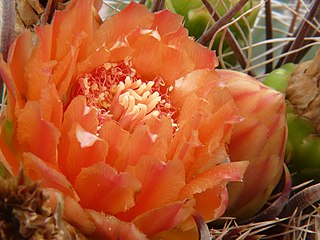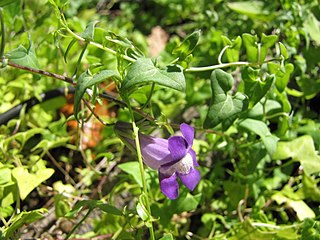
Populus section Aigeiros is a section of three species in the genus Populus, the poplars. Like some other species in the genus Populus, they are commonly known as cottonwoods. The species are native to North America, Europe, and western Asia. In the past, as many as six species were recognized, but recent trends have been to accept just three species, treating the others as subspecies of P. deltoides.

Rhodochiton is a genus of flowering plants within the family Plantaginaceae, native to southern Mexico and neighbouring Guatemala. They climb by means of twining leaf stalks. One of the three species, Rhodochiton atrosanguineus, the purple bell vine, is grown as an ornamental plant. All three species are sometimes included in Lophospermum.

Lophospermum is a genus of herbaceous perennial climbers or scramblers, native to mountainous regions of Mexico and Guatemala. Those that climb use twining leaf stalks. Their flowers are tubular, in shades of red, violet and purple, the larger flowers being pollinated by hummingbirds. Now placed in the greatly expanded family Plantaginaceae, the genus was traditionally placed in the Scrophulariaceae. The close relationship with some other genera, particularly Maurandya and Rhodochiton, has led to confusion over the names of some species.

Ferocactus wislizeni, the fishhook barrel cactus, also called Arizona barrel cactus, candy barrel cactus, and Southwestern barrel cactus, is a species of flowering plant in the cactus family Cactaceae, native to northern Mexico and the southern United States. It is a ball-shaped cactus eventually growing to a cylindrical shape, with spiny ribs and red or yellow flowers in summer.

Senna wislizeni, commonly called Wislizenus' senna or shrubby senna. Formerly in the "wastebin taxon" Cassia sensu lato, it is now placed in the genus Senna or sometimes separated in Palmerocassia together with Senna unijuga.

Asarina is a flowering plant genus of only one species, Asarina procumbens Mill. the trailing snapdragon, which is native to France and Spain and introduced in Germany, Switzerland, Austria and Hungary. Originally placed in the Scrophulariaceae, the genus has more recently been moved to the Plantaginaceae. Species from North America formerly placed in the genus Asarina are now placed in Holmgrenanthe, Lophospermum, Mabrya and Maurandya, as well as Neogaerrhinum. Asarina is now regarded as exclusively an Old World genus.

Maurandya is a genus of flowering plants in the family Plantaginaceae, native to Mexico and the south west United States. They sprawl or climb by means of twining leaf stalks. One of the four species, Maurandya barclayana, is widely cultivated as an ornamental plant.

Rhodochiton atrosanguineus is a herbaceous perennial vine native to Mexico. It has been cultivated as an ornamental plant since at least 1836.

Maurandella antirrhiniflora, known as roving sailor or climbing snapdragon, is a species of flowering plant in the family Plantaginaceae. It is the sole species in genus Maurandella. It is a scrambling or climbing herbaceous perennial subshrub native to Mexico, the southwestern United States, Cuba, and the Turks and Caicos Islands, where it grows in a variety of relatively dry subtropical habitats.

Lophospermum purpusii is a scambling or climbing herbaceous perennial native to Mexico. It has tubular flowers, white at the base and red to violet elsewhere.
Rhodochiton hintonii is a climbing or sprawling herbaceous perennial native to the state of Guerrero in Mexico. It has dangling flowers, with a bell-shaped calyx and dark purple petals forming a tube. Unlike the better known Rhodochiton atrosanguineus, the petal tube is asymmetrical with two "lips".
Rhodochiton nubicola is a climbing or sprawling herbaceous perennial native to the state of Chiapas in Mexico and to Guatemala, where it grows in cloud forests at between 1,300 and 3,000 m. It has dangling flowers, with a bell-shaped calyx and dark purple petals forming a tube. Unlike the better known Rhodochiton atrosanguineus, the petal tube is asymmetrical with two "lips".
Lophospermum breedlovei is a climbing or scrambling herbaceous perennial native only to the state of Chiapas in Mexico. It has tubular flowers, white at the base and dark purple elsewhere. It was first described by Wayne J. Elisens in 1985. The epithet breedlovei commemorates Dennis E. Breedlove, described as a "prolific plant collector and authority on the flora of Chiapas".
Lophospermum turneri is a climbing or scrambling herbaceous perennial native to Guatemala and the state of Chiapas in Mexico, where it was first collected. It has tubular flowers, lavender to violet in colour. It was first described by Wayne J. Elisens in 1985. The epithet turneri commemorates Billie L. Turner, described as "mentor of many students of the Latin American flora".

Mabrya acerifolia, or brittlestem, is a mat-forming herbaceous perennial native to south-central Arizona. It has pale yellow tubular flowers. It was first described by Francis W. Pennell in 1924 in the genus Maurandya and transferred to Mabrya by Wayne J. Elisens in 1985. The epithet acerifolia refers to the somewhat maple-like shape of its leaves.
Mabrya geniculata is a mat-forming herbaceous perennial native to the Mexican states of Sonora and Chihuahua. It has pale yellow tubular flowers. It was first described in 1894 by Benjamin L. Robinson and Merritt L. Fernald in the genus Maurandya and transferred to Mabrya by Wayne J. Elisens in 1985.
Mabrya flaviflora is a mat-forming herbaceous perennial native to a small area in Baja California Norte, Mexico. It has pale yellow tubular flowers. It was first described by Ivan M. Johnston in 1924 in the genus Maurandya and transferred to Mabrya by Wayne J. Elisens in 1985 as Mabrya geniculata subsp. flaviflora. It was restored to a full species within Mabrya by David A. Sutton in 1988. The epithet flaviflora means yellow-flowered.
Mabrya coccinea is a mat-forming herbaceous perennial native to the Mexican state of Coahuila. It has red tubular flowers. It was first described by Ivan M. Johnston in 1950 in the genus Maurandya and transferred to Mabrya by Wayne J. Elisens in 1985. The epithet coccinea means red.
Mabrya rosei is a mat-forming herbaceous perennial native to the Mexican states of Jalisco and Zacatecas. It has tubular flowers, whitish at the base and red to red-violet at the apex. It was first described by Philip A. Munz in 1926 in the genus Maurandya and transferred to Mabrya by Wayne J. Elisens in 1985. Munz did not explain the origin of the epithet rosei but listed the collector of the type specimen as Joseph Nelson Rose.
Mabrya erecta is an upright herbaceous perennial native to Mexico – the states of Chihuahua, Coahuila, Durango, Nuevo León and possibly México. Unlike other members of the genus Mabrya, it does not form mats. It has tubular flowers, whitish at the base and pink to red-violet at the apex. It was first described by William B. Hemsley in 1882 in the genus Maurandya and transferred to Mabrya by Wayne J. Elisens in 1985. The epithet erecta means erect or upright.












